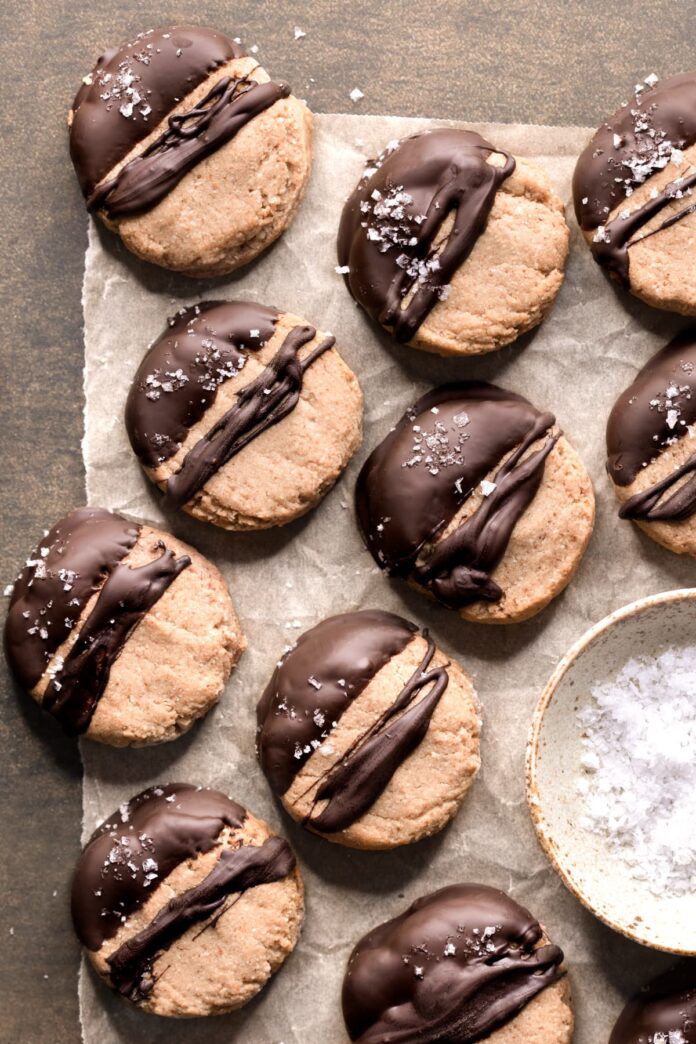These chocolate-dipped Almond Olive Oil Shortbread Cookies are a healthy twist on a classic shortbread biscuit. They are gluten free, dairy free, vegan and easy to make with just six ingredients. You might already have what you need in your pantry.
Regular shortbread cookies are traditionally made with white sugar, butter and a blend of wheat flour and rice flour. They also don’t include leavening agents, like baking powder or baking soda. This is what gives them their crumbly texture. If you enjoy shortbread but want to bake with more whole food ingredients, this recipe could be the answer.
Cookies with olive oil instead of butter
Replacing butter with olive oil when baking cookies has become quite popular. If you’re making the switch to reap the health benefits of olive oil, then you want to use extra virgin olive oil and be mindful of the temperature of your oven.
The key difference between extra virgin olive oil and other olive oils is the method used for extracting the oil from the olives. Extra virgin olive oil is cold pressed, which means that the oil is extracted without the use of chemicals or heat. This preserves a higher level of natural antioxidants and healthy fats. Other olive oils, such as refined olive oil, don’t provide the same health benefits.
Another thing to keep in mind is the temperature of your oven when baking olive oil cookies. Extra virgin olive oil has a smoke point of approximately 190 to 207°C / 374 to 405°F. You want to keep your baking temperature below that. This is because heating oils above their smoke point degrades the beneficial compounds in the oil.
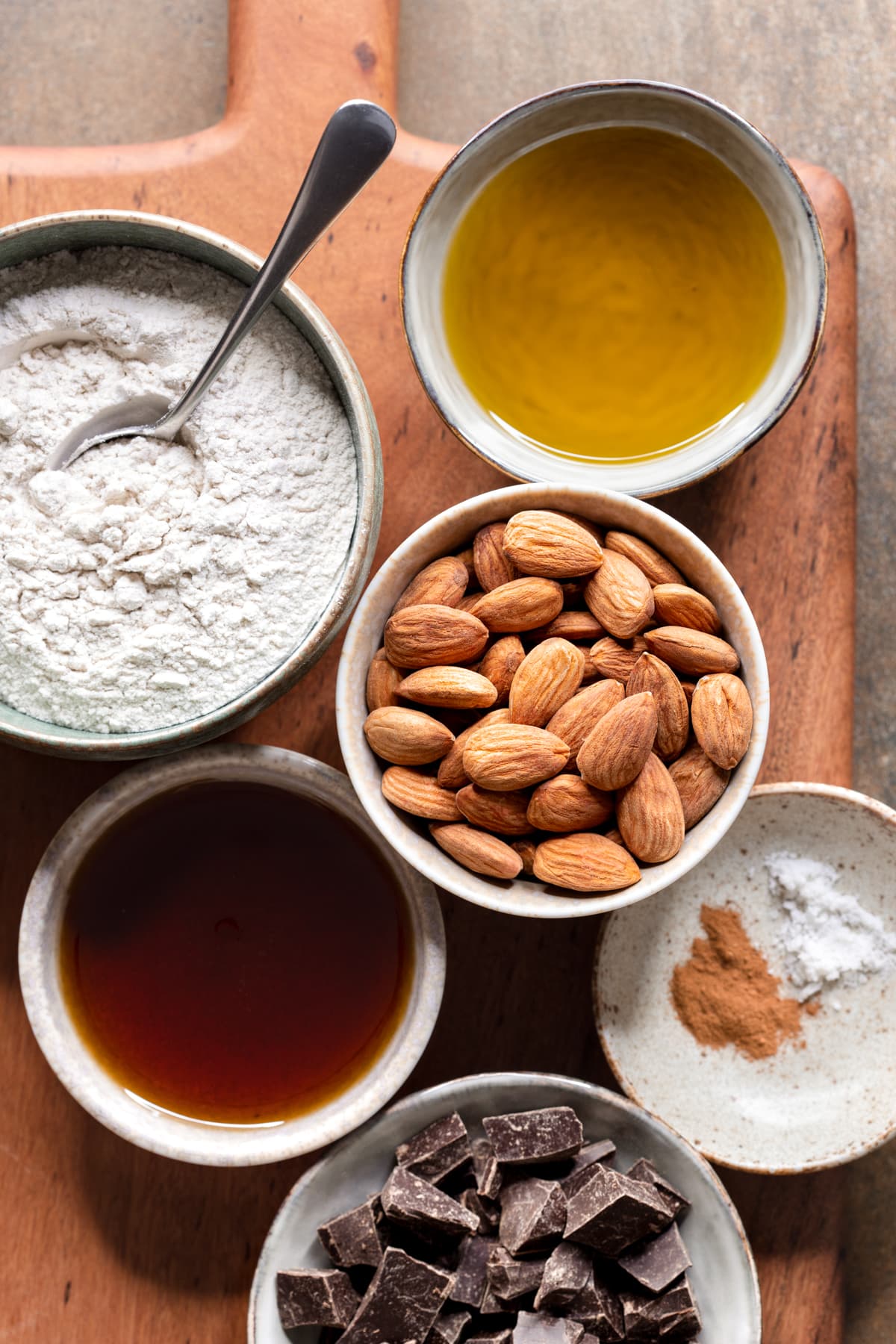
Benefits of using a food scale for baking
For baking recipes, I always recommend weighing your ingredients on a food scale. There are two main reasons for this:
- It is more accurate than cup measurements: This is particularly important when working with dry ingredients like flours. The way that you place dry ingredients into a cup measure can give varying results. For example, dunking the cup into a bag of flour results in more flour by weight than gently spooning flour into the cup. This is because the scooping action compresses the flour as it enters the cup. Too much flour in a baking recipe can leave you with dry, disappointing results.
- It saves on washing up: Using a food scale allows you to measure your ingredients straight into one bowl. So you don’t have to wash up a bunch of different measuring cups and spoons.
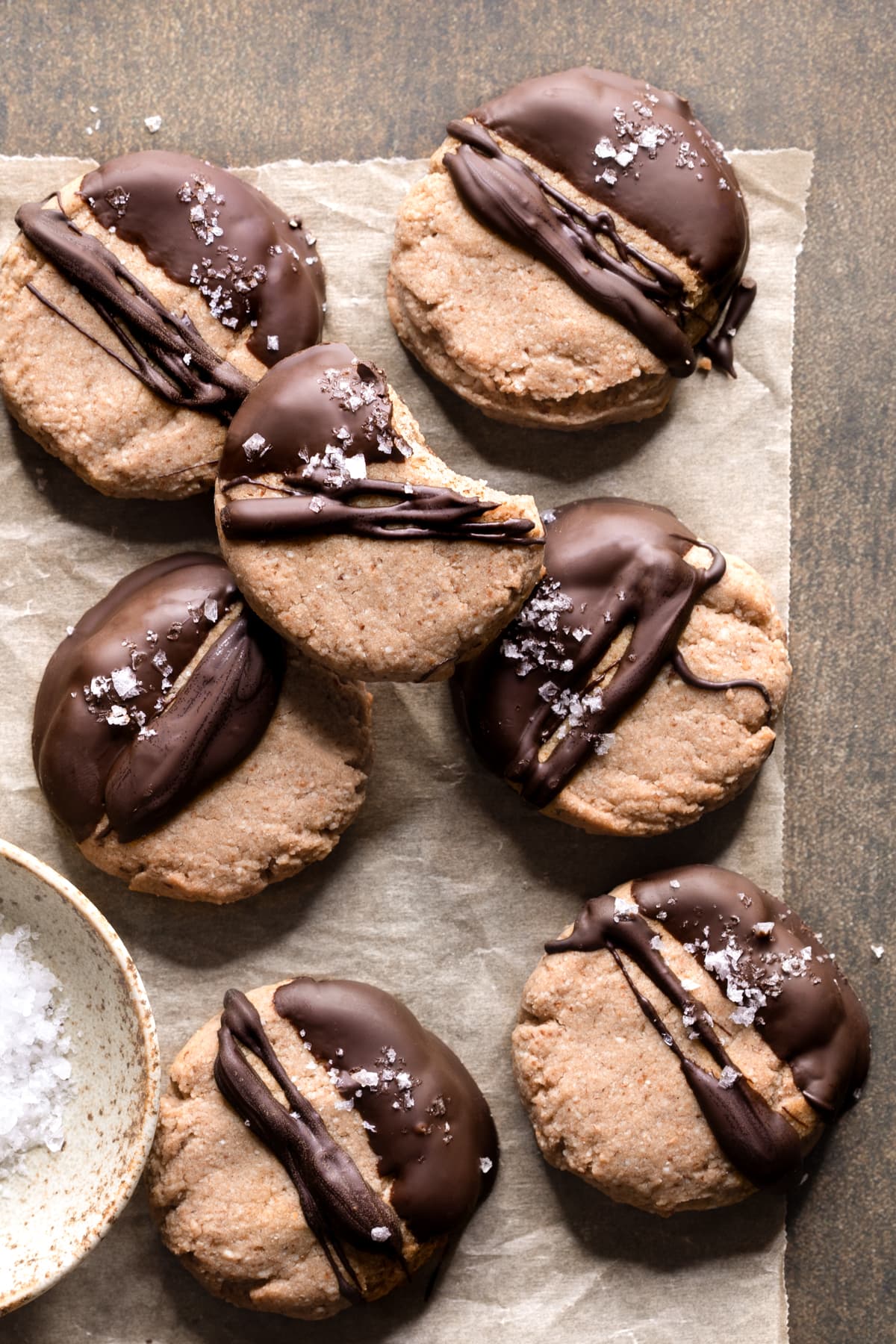
How to use a food scale
- Place your vessel on the scale: Your vessel could be a mixing bowl, pot, pan, plate or a container. Whatever you are using to mix or gather your ingredients. The scales will show the weight of the vessel.
- Hit the tare, or zero, button: This resets the scales to zero, so the weight of your vessel isn’t included in what you are about to measure.
- Measure out your first ingredient: Slowly add your first ingredient until the desired weight is shown on the scale.
- Hit the tare, or zero, button again: This resets the scale to zero again, so you are ready to weigh out your next ingredient.
- Repeat: Continue to measure out the rest of your ingredients, pressing tare or zero between each one.
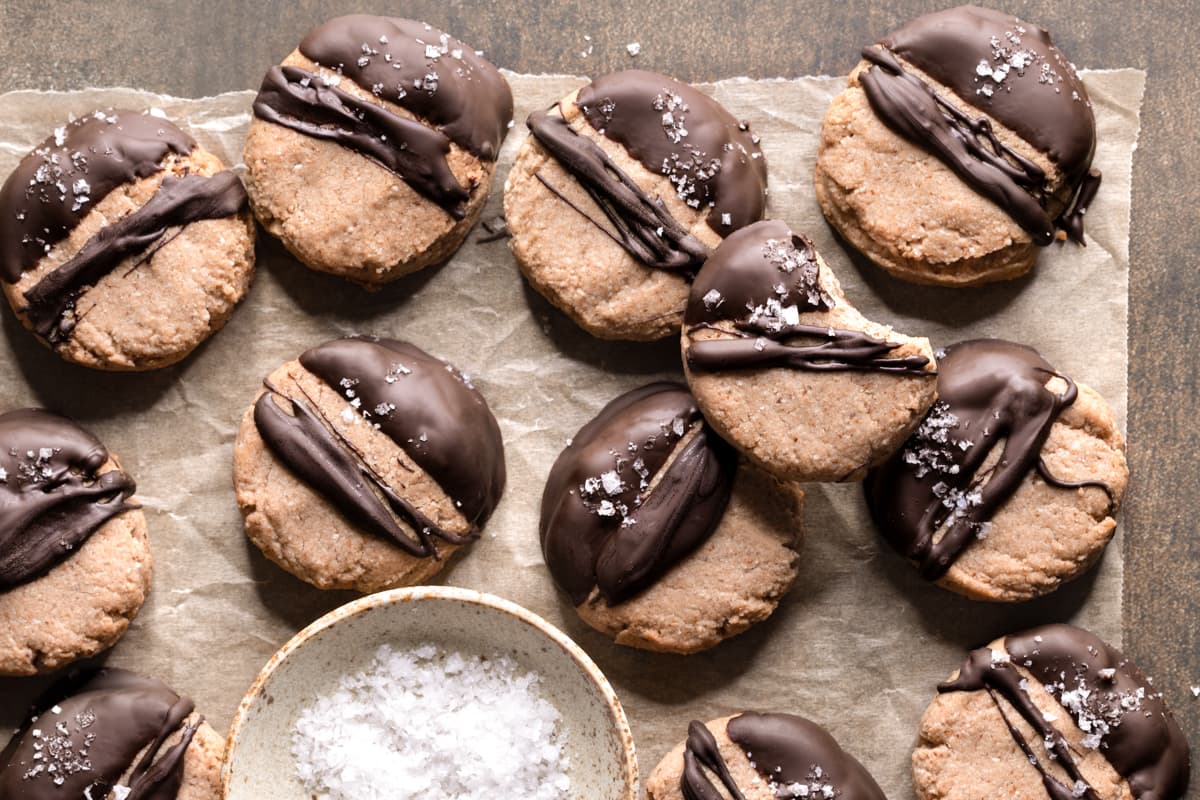
Ingredients for almond olive oil shortbread cookies
- Raw almonds: Raw and unsalted almonds work best in this recipe. We blend them into a flour before adding to the recipe. I store nuts in the fridge to keep them fresher for longer.
- Buckwheat flour: Using buckwheat flour keeps the recipe gluten free. It also contributes to the shortbread texture of the cookies. You can buy buckwheat flour at many supermarkets. It’s usually stocked in the health food aisle, or along with the regular flours.
- Cinnamon powder: Just a small amount of cinnamon gives the cookies a little boost. It’s not a key flavor of the cookies though, so you can leave it out if you prefer.
- Fine salt: To season the cookie mixture. It really helps to enhance the flavors.
- Maple syrup: To sweeten the cookies. Maple syrup works best in this recipe because its sweetness balances out the earthiness of the buckwheat flour and extra virgin olive oil.
- Extra virgin olive oil: Using extra virgin olive oil instead of butter keeps the cookies dairy free and vegan. It also provides a unique flavor.
- Dark chocolate: For dipping and drizzling over the cookies once they have cooled. You can use any chocolate you like. If you need the cookies to be strictly vegan, check that your chocolate does not contain milk solids. Most good quality dark chocolate with at least 70% cocoa content won’t contain milk solids.
- Sea salt flakes: To sprinkle over the chocolate coating. It’s totally optional though.
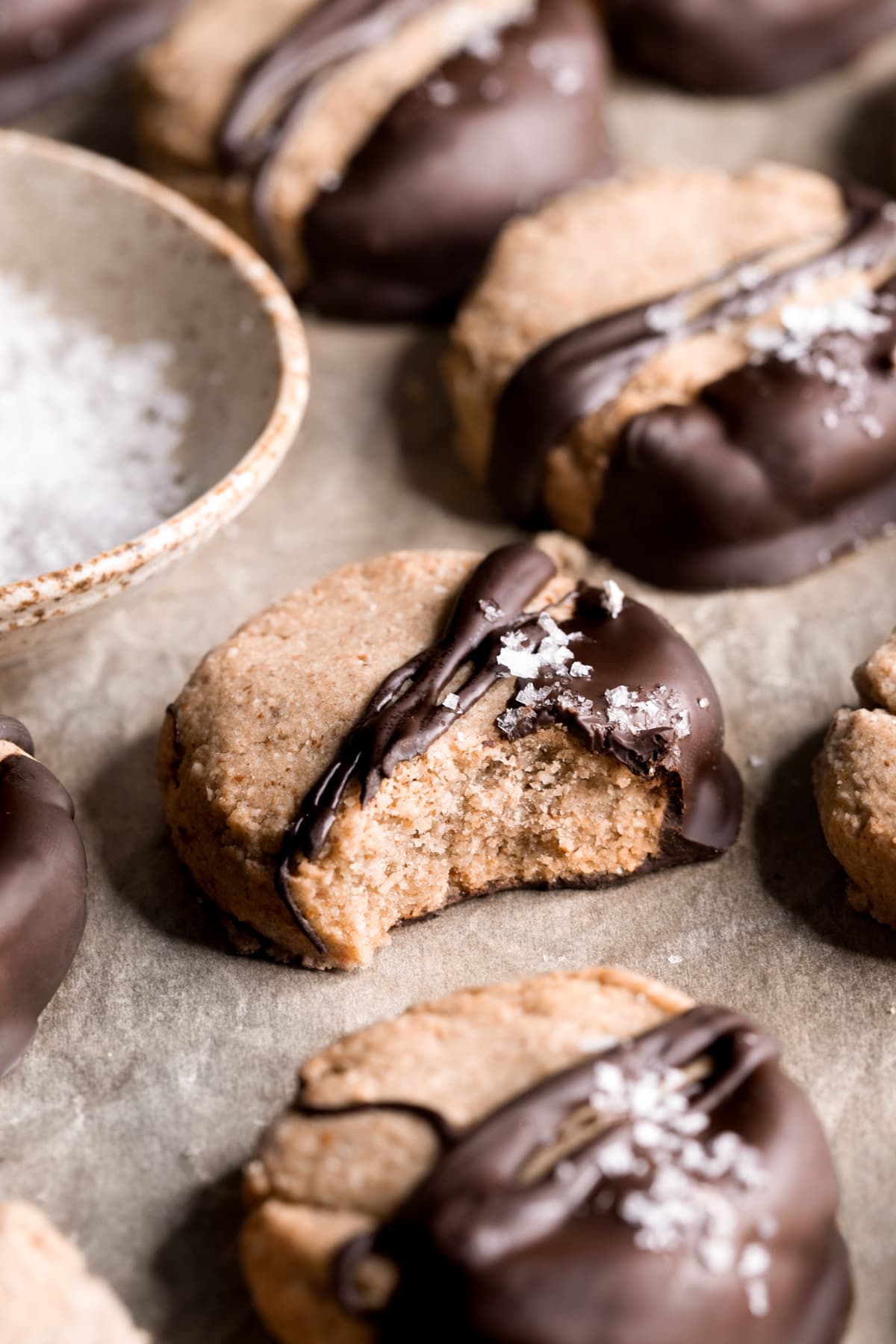
More healthy baking recipes
- Gluten Free Almond Blondies with Olive Oil
- Small Batch Paleo Chocolate Chip Cookies
- Gluten Free Gingerbread Cookies with Almond Flour
- Buckwheat Jam Thumbprint Cookies
- Gluten Free Gingerbread Cake without Molasses
Check out the Baking Recipes page for more healthy baking ideas.
Almond Olive Oil Shortbread Cookies Recipe
Serves
12 cookies
Prep time
20 mins
Cook time
20 mins
Ingredients
- 3/4 cup / 107 g raw almonds
- 1 cup / 120 g buckwheat flour (see Note 1)
- 1/4 tsp cinnamon powder
- 1/4 tsp fine salt
- 1/4 cup / 60 ml / 80 g maple syrup
- 1/4 cup / 60 ml / 55 g extra virgin olive oil (see Note 2)
- 2.1 oz / 60 g dark chocolate
- Sea salt flakes, to sprinkle
Method
- Preheat your oven to 160°C fan-forced / 180°C / 350°F and line a baking tray with baking paper.
- Process the almonds in a food processor or blender to turn them into a flour consistency. Tip the almond flour into a mixing bowl, then add the buckwheat flour, cinnamon and salt. Stir to combine. Add the maple syrup and olive oil and mix well until you get a dough.
- Press the mixture into 12 balls and place them onto the lined baking tray (see Note 3). Flatten each ball into a cookie shape. The cookies won’t spread and will stay the same shape as they bake.
- Bake in the preheated oven for 20 to 25 minutes or until the edges of the cookies are just starting to brown. Allow the cookies to cool on the tray.
- Once the cookies are completed cold, melt the chocolate in the microwave or using a double boiler. Allow the melted chocolate to cool slightly so it thickens, then dip each cookie into the chocolate and place on a tray lined with baking paper. Sprinkle with sea salt flakes if desired, then refrigerate until the chocolate sets.
Notes
- Flour – I recommend weighing your buckwheat flour in grams on a food scale for best results. I explain how to use a food scale in the body of this post above.
- Olive oil – Extra virgin olive oil is ideal if you have it. However, any olive oil will work provided it’s not a flavored or infused oil like garlic or chili oil.
- Cookie dough scoop – A cookie dough or ice cream scoop with a release handle makes it easy to divide the mixture into even portions. Firmly pack the mixture into the scoop, then release it onto the tray. You can watch the recipe video above to see how I do this. My scoop is 1.5 inches or 4 cm in diameter, which gives 12 cookies.
- Storage – You can store the cookies in an airtight container at room temperature. However, I like to store them in the fridge for maximum freshness.
Nutrition Facts
- Serving size: 1 cookie (made with 70% cocoa dark chocolate)
- Energy: 172 Calories / 721 Kilojoules
- Total Fat: 11.5 g
- Saturated Fat: 2.2 g
- Total Carbohydrate: 15 g
- Dietary Fiber: 2.8 g
- Sugars: 4.5 g
- Protein: 3.5 g
- Sodium: 52 mg
- Potassium: 108 mg
